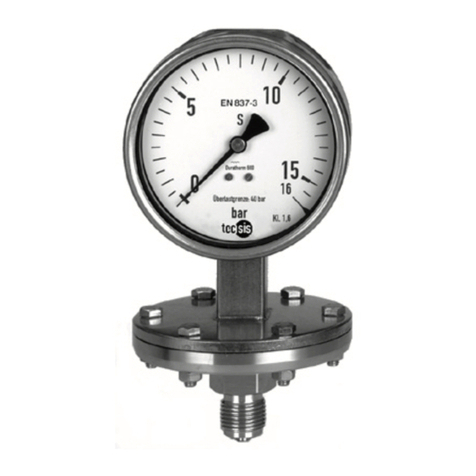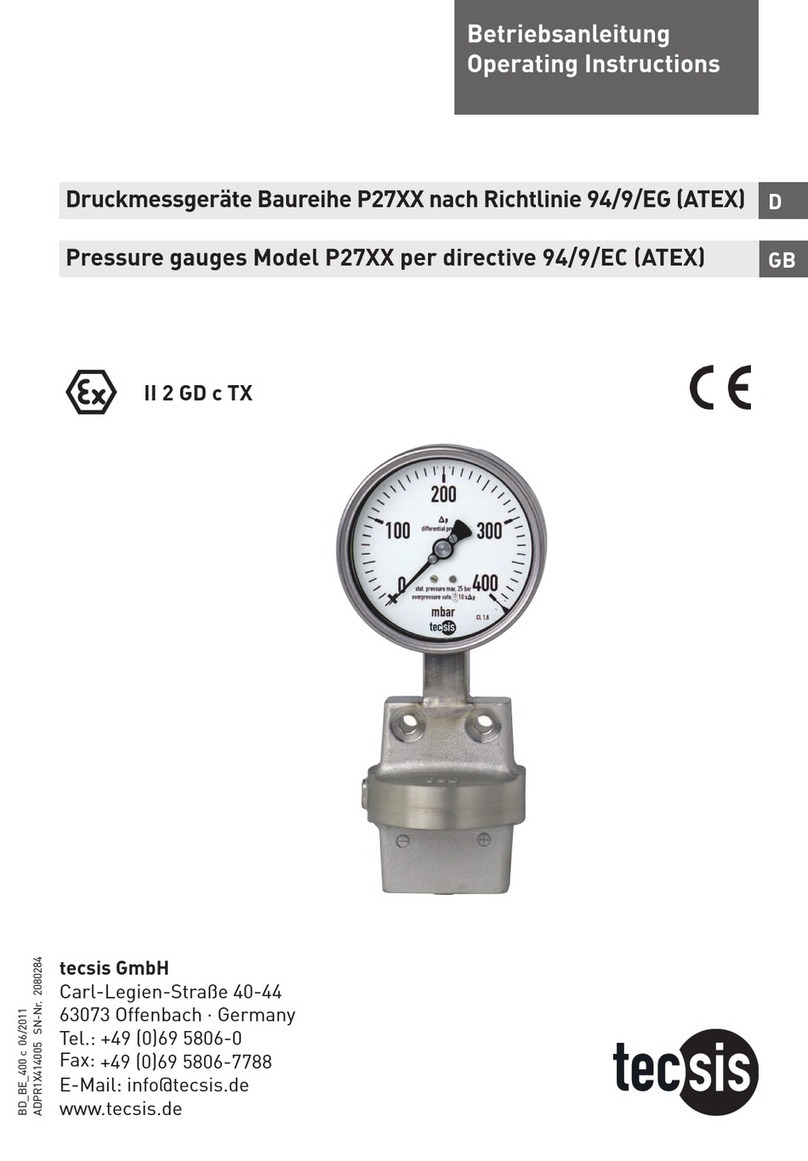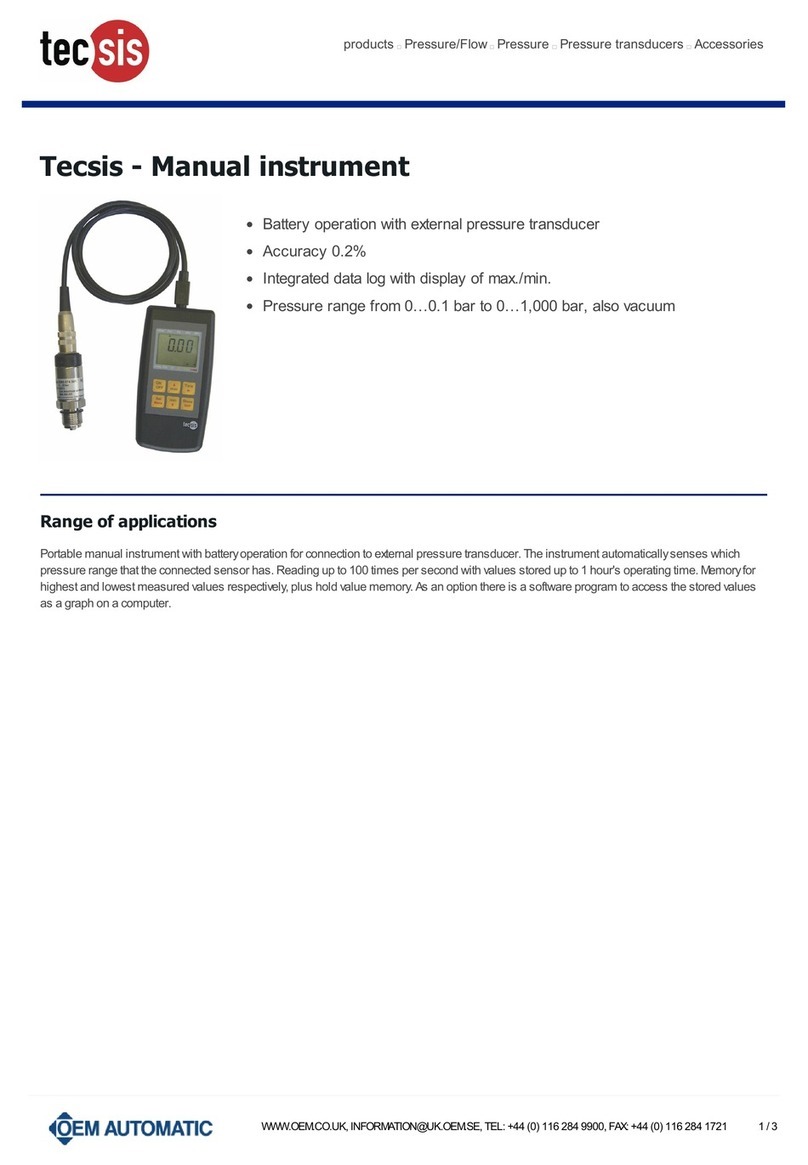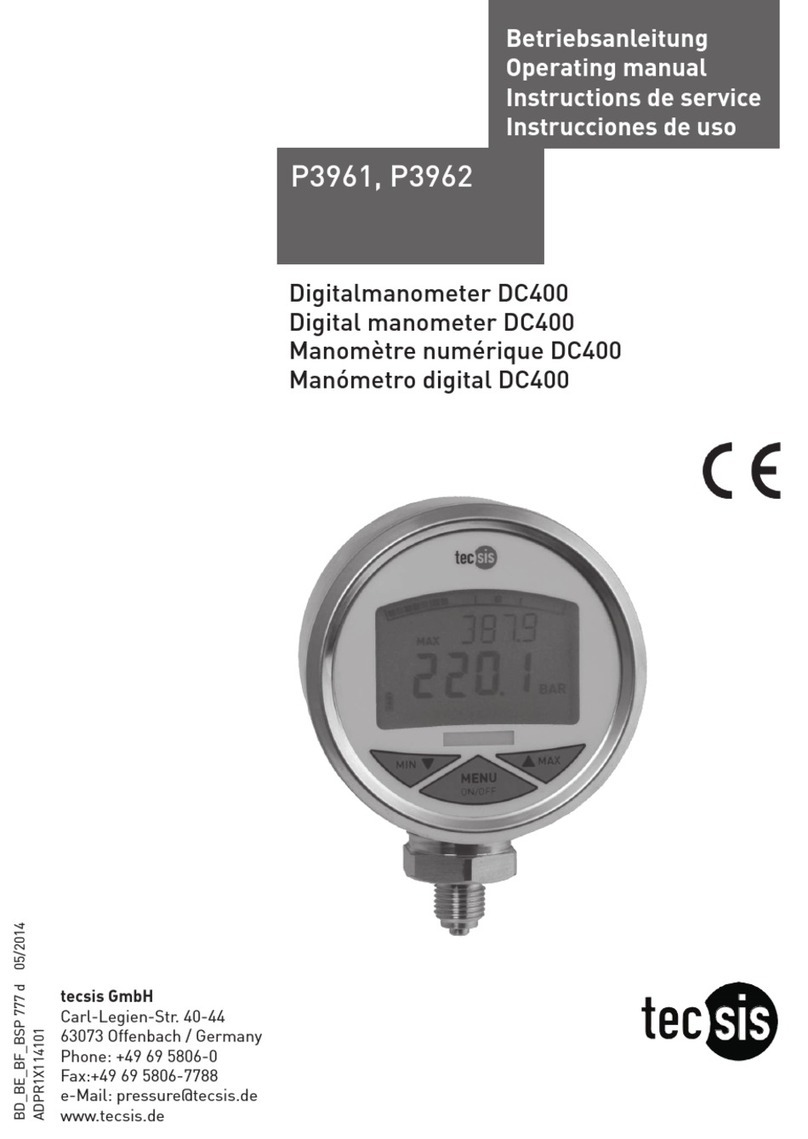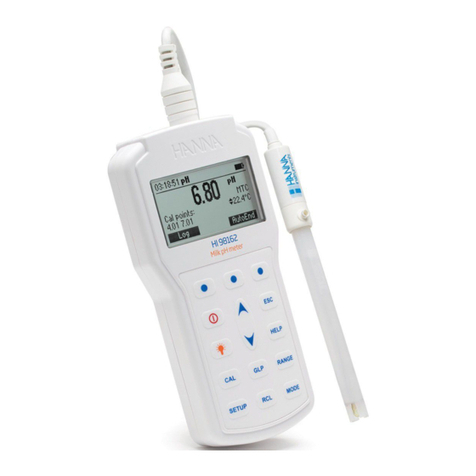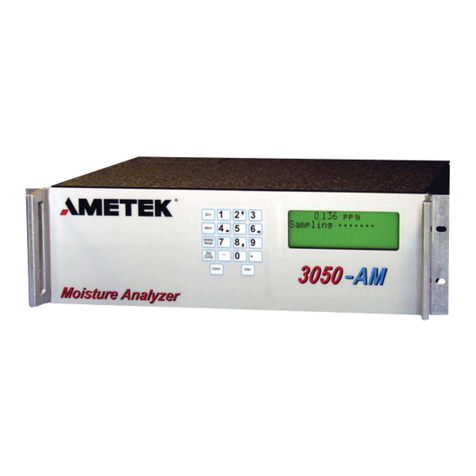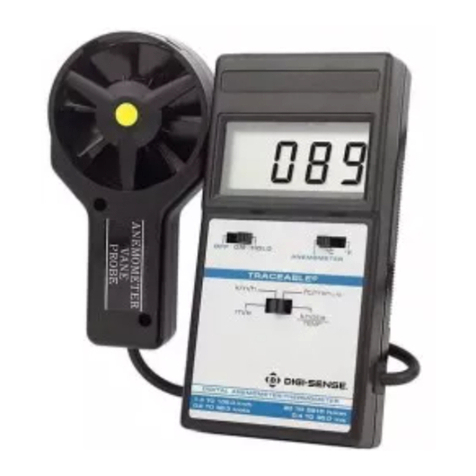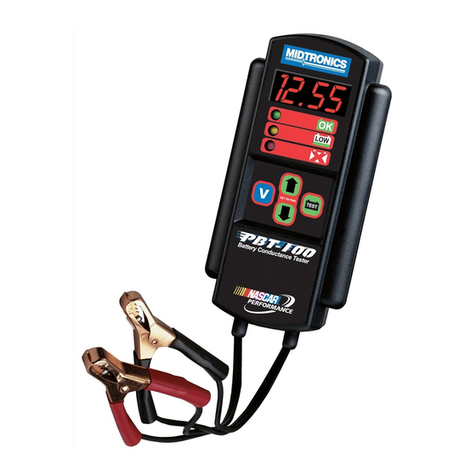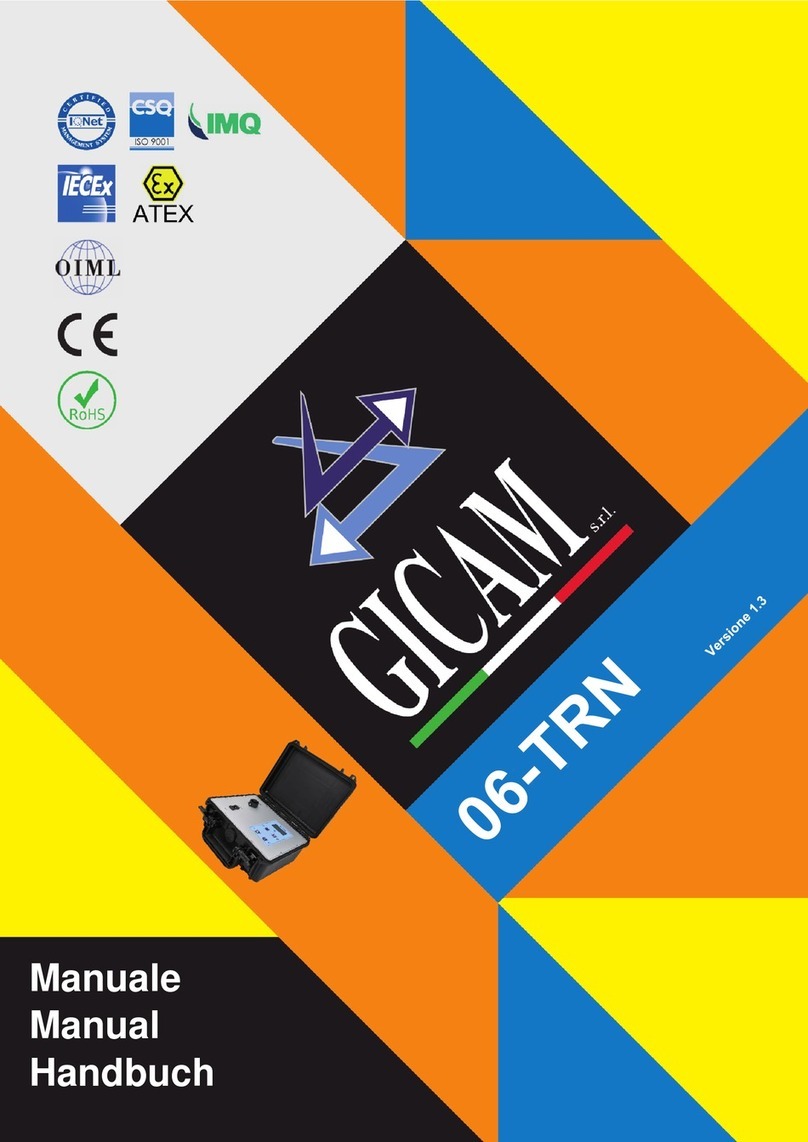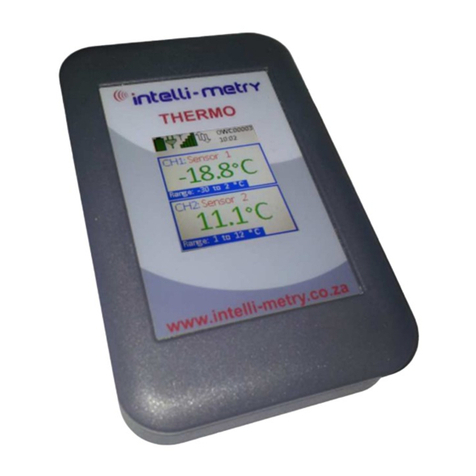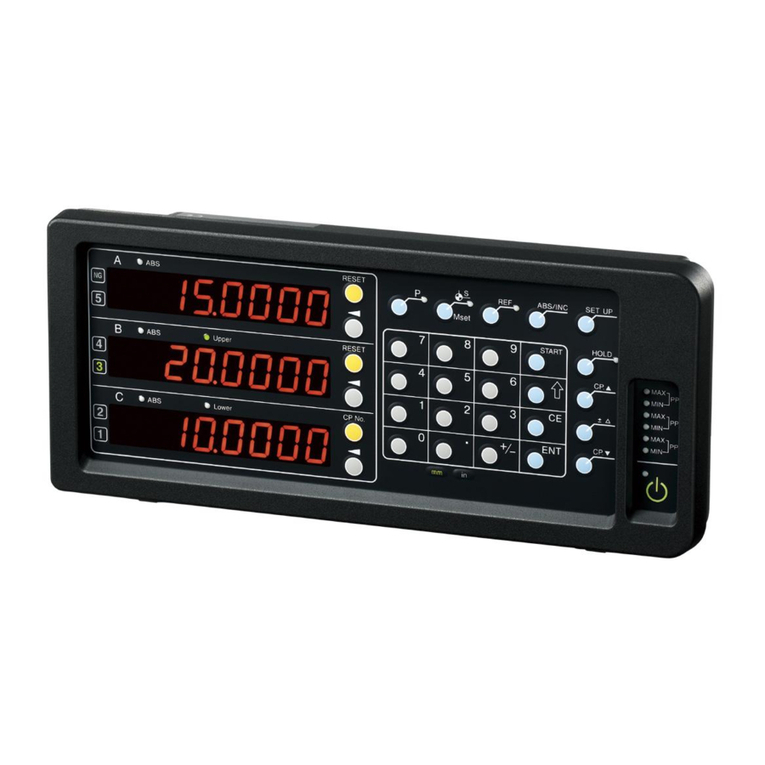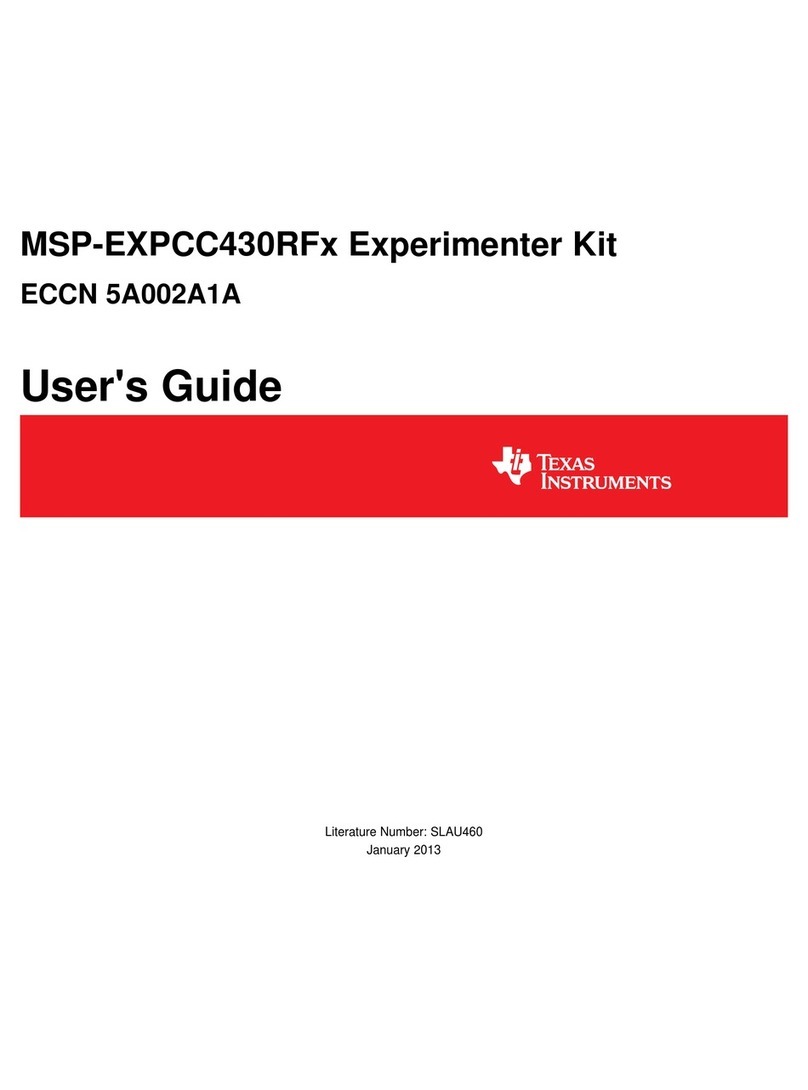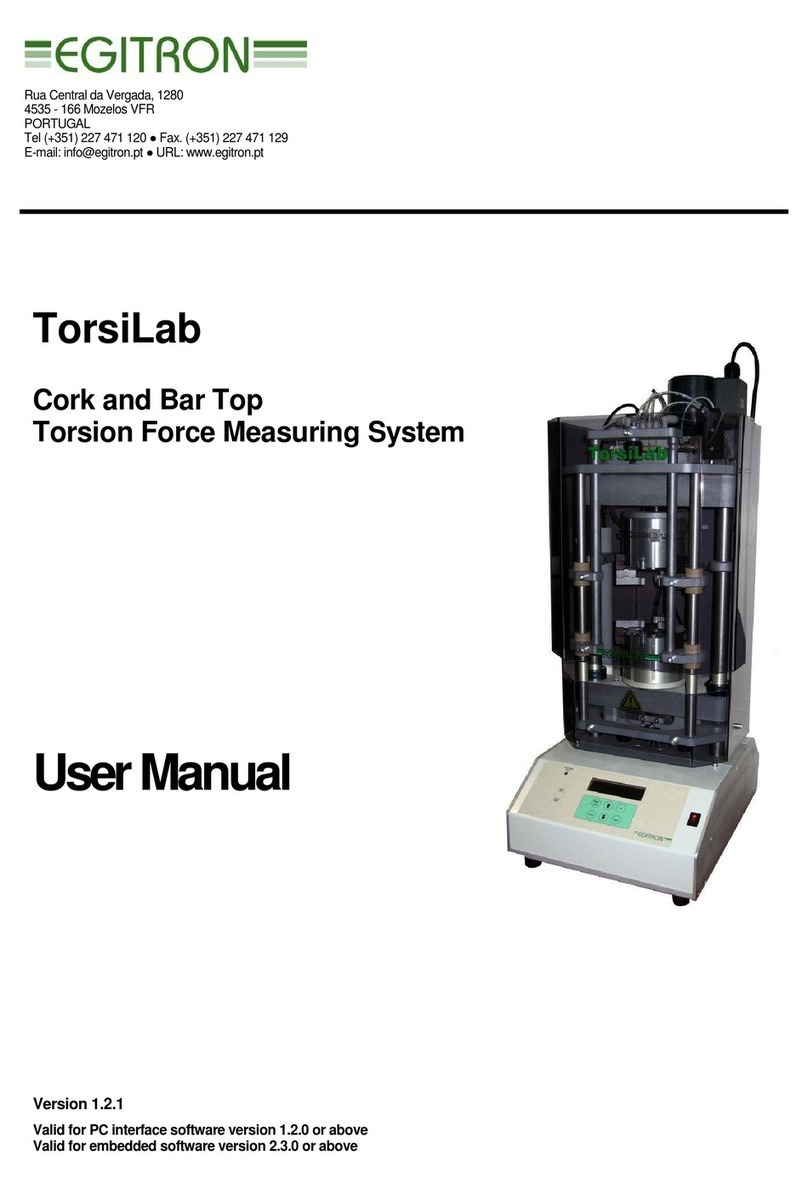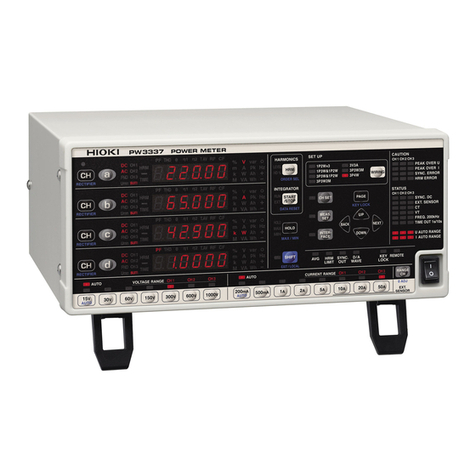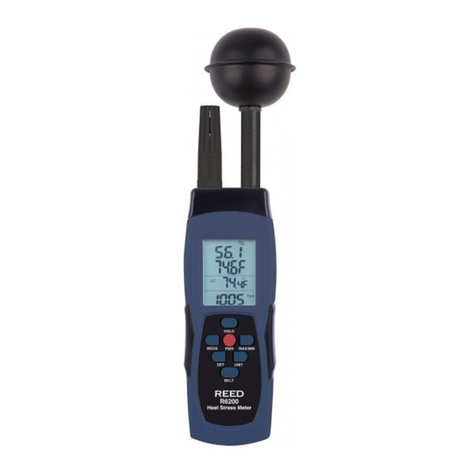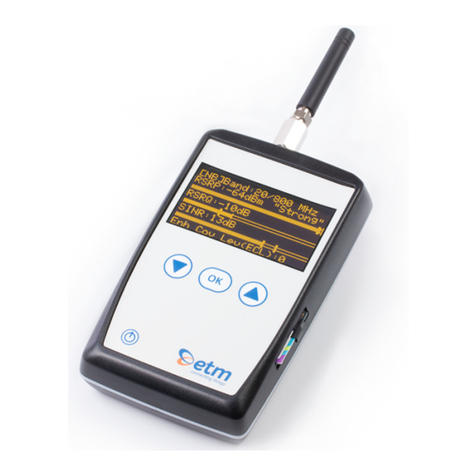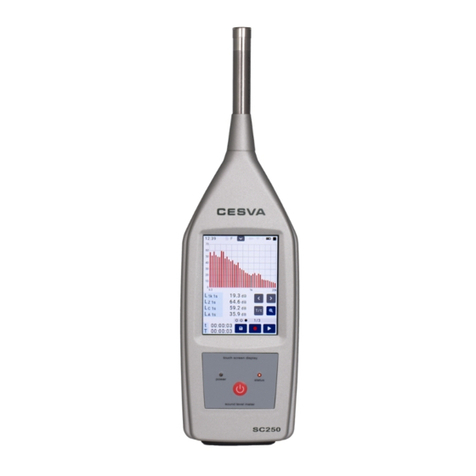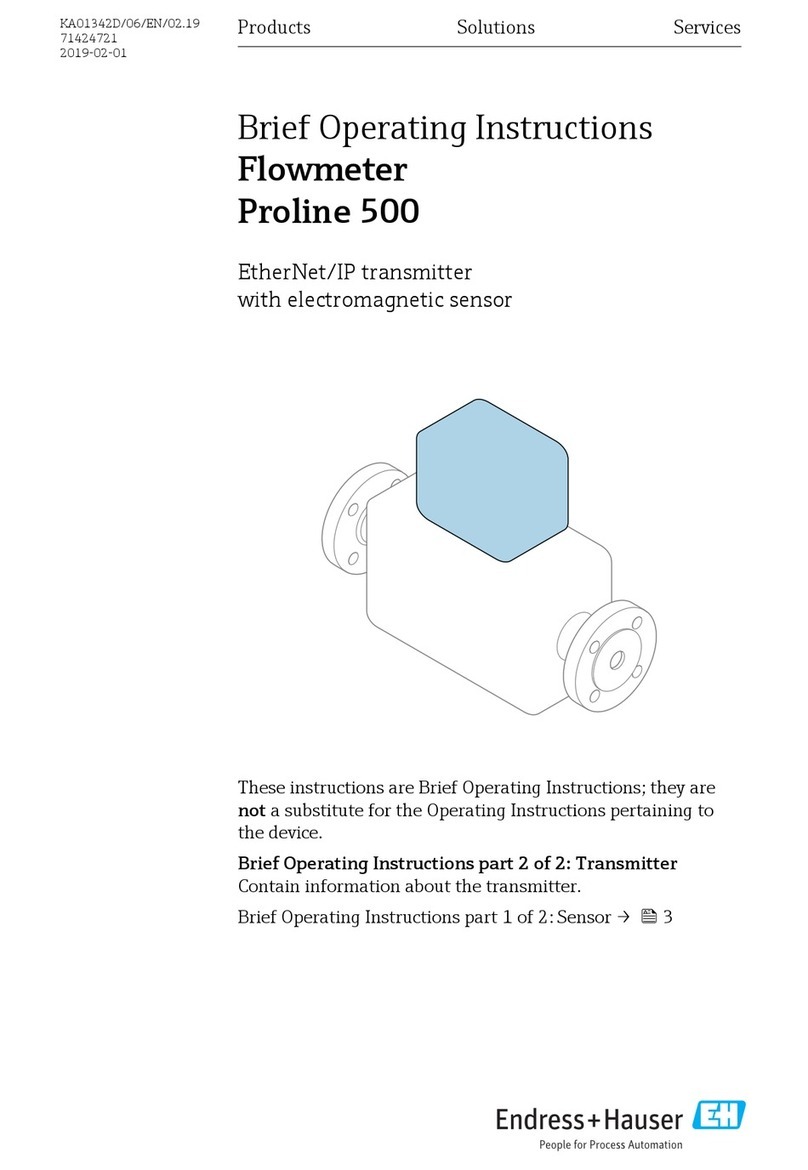Tecsis TM1 Series User manual

D
GB
F
Betriebsanleitung
Operating instructions
Mode d'emploi
Manual de instrucciones
E
tecsis GmbH
Carl-Legien-Str. 40-44
63073 Offenbach / Germany
Phone: +49 69 5806-0
Fax: +49 69 5806-7788
e-Mail: [email protected]om
www.tecsis.com
BD_BE_BF_BSP 1139 05/2015
Bimetall-Thermometer TM1xx, T41xx-T44xx
für Heizungs-, Klima- und Lüftungstechnik
Bimetal thermometers TM1xx, T41xx-T44xx
for heating, ventilation and air-conditioning
Thermomètres bimétalliques TM1xx, T41xx-T44xx
pour le chauffage, ventilation et conditionnement d'air
Termómetros bimetálicos TM1xx, T41xx-T44xx
para la calefacción, ventilación y climatización

D
GB
F
E
2 tecsis operating instructions bimetal thermometers TM2xx-TM3xx
BD_BE_BF_BSP 1139 05/2015
Betriebsanleitung Bimetall-Thermometer
für Heizungs-, Klima- und Lüftungstechnik Seite 9 - 14
Operating Instructions Bimetal thermometers
for heating, air-conditioning and air-conditioning Page 3 - 8
Mode d'emploi thermomètres bimétalliques pour
le chauffage, ventilation et conditionnement d'air Page 15 - 20
Manual de Instrucciones de termómetros bimetálicos
para la calefacción, ventilación y climatización Página 21 - 25

D
Inhalt
1. Allgemeiner Hinweis 4
2. Transport und Lagerung 4
3. Sicherheitshinweise 4
4. Einbaubedingungen und Montage 5
5. Maßnahmen zur Störungsbeseitigung 5
6. Anzeigekontrolle 6
7. Anzeigekorrektur 6
8. Wartung / Reinigung 7
9. Reparaturen 7
10. Entsorgung 7
tecsis Betriebsanleitung Bimetall-Thermometer TM2xx-TM3xx 3
BD_BE_BF_BSP 1139 05/2015
Inhalt
Information
Dieses Zeichen gibt Ihnen Informationen, Hinweise oder Tipps.
Warnung!
Dieses Symbol warnt Sie vor Handlungen, die Schäden an Personen
oder am Gerät verursachen können.

D
1. Allgemeiner Hinweis ... 3. Sicherheitshinweise
tecsis Betriebsanleitung Bimetall-Thermometer TM2xx-TM3xx4
BD_BE_BF_BSP 1139 05/2015
1. Allgemeiner Hinweis
Bitte lesen sie diese Bedienungsanleitung vor der Inbetrieb-
nahme des Thermometers.
Diese Bedienungsanleitung enthält Hinweise für die Montage, Inbetriebnah-
me und Wartung. Neben dieser Betriebsanleitung sind auch zu beachten: die
gesetzlichen Vorschriften, die bestehenden Normen, die ergänzenden techni-
schen Daten des betreffenden Datenblattes und ggf. zusätzliche Bescheinigun-
gen.
Bestimmungsgemäßer Gebrauch: Die Bimetall-Thermometer werden haupt-
sächlich in der Heizungs-, Klima- und Kältetechnik eingesetzt, um die Tempe-
ratur des Prozesses zu überwachen.
2. Transport und Lagerung
Die Thermometer sind unter trockenen und sauberen Bedingungen und
möglichst in den Originalverpackungen zu lagern und zu transportieren.
Stöße und Vibrationen sind zu vermeiden. Die Thermometer sind vor direkter
Sonneneinstrahlung, Staub, Insekten, feuchter Luft und sonstiger aggressiver
Atmosphäre zu schützen. Das Verpackungsmaterial ist genau durchzusehen,
damit keine evtl. beigepackten Zubehörteile verloren gehen.
Zulässige Lagertemperatur: -20 … +60 °C
3. Sicherheitshinweise
Beachten Sie unbedingt bei Montage, Inbetriebnahme und Betrieb
dieser Geräte die entsprechenden nationalen Sicherheitsvorschrif-
ten (z. B. EN 60 079-14 / EN 837-2).
■
Bei Nichtbeachten der entsprechenden Vorschriften können schwere
Körperverletzungen und/oder Sachschäden auftreten.
■
Nur entsprechend qualifiziertes Personal darf an diesen Geräten arbeiten.

D
4. Einbaubedingungen, Montage / 5. Maßnahmen zur ...
tecsis Betriebsanleitung Bimetall-Thermometer TM2xx-TM3xx 5
BD_BE_BF_BSP 1139 05/2015
4. Einbaubedingungen und Montage
Vor der Montage ist darauf zu achten, dass das je nach Gehäusebefestigungsart
notwendige Zubehör vorhanden ist. Das Zubehör ist eingebaut oder
befindet sich in einem meist am Thermometer befestigten Beutel.
■
Vor dem Einbau der Schutzhülse ist zu prüfen, ob der verwendete Werkstoff
(aus dem Lieferschein ersichtlich) gegenüber dem Messmedium chemisch
beständig/neutral ist.
■
Wärmeableitungsfehler entstehen, wenn der Messraum, dessen Temperatur
angezeigt werden soll, sehr klein ist, so dass sich die Masse des Tempera-
turfühlers als Wärmekapazität bemerkbar macht. Solche Erscheinungen
können auch bei nicht genügender Einbautiefe entstehen, wenn die Befesti-
gungs-armatur an einem guten Wärmeleiter (Stahlplatten oder dergleichen)
befestigt ist und ein erheblicher Temperaturunterschied zwischen der Mess-
und der Befestigungselement-Temperatur besteht.
5. Maßnahmen zur Störungsbeseitigung
Bimetall-Thermometer sind ihrer Grundkonstruktion entsprechend wartungs-
freie Geräte. Als messende Geräte sollte man sie in applikationsabhängigen
Zeitabständen auf Messgenauigkeit kontrollieren. Temperaturfühler, die einer
dauernden, wenn auch geringfügigen thermischen Beanspruchung unterwor-
fen sind sind von Zeit zu Zeit auf den Verschleißzustand zu kontrollieren.
Bei sichtbarer Beschädigung ist das Gerät auszutauschen.
tecsis empfiehlt ausdrücklich Maßnahmen bei Schäden durch Austreten des
Mediums zu ergreifen.

D
6. Anzeigekontrolle / 7. Anzeigekorrektur
tecsis Betriebsanleitung Bimetall-Thermometer TM2xx-TM3xx6
BD_BE_BF_BSP 1139 05/2015
6. Anzeigekontrolle
Die Kontrolle der Anzeige sollte nur im Vergleich zu einem genaueren oder
möglichst kalibrierten Gerät erfolgen. Die Kontrolltemperatur muss konstant
sein. Bei veränderlichen Temperaturen entstehen Ablesefehler, die ihre
Ursache in unterschiedlichen Ansprechzeiten der Fühler haben.
Bei Thermometern ohne Schutzhülsen sollte bei voller ordnungsgemäßer
Eintauchlänge eine Mindestwartezeit von 10 Minuten zum Temperaturausgleich
eingehalten werden.
Achtung: Nur gasförmige, drucklose Messstoffe zulässig!
Bei Thermometern mit Schutzhülsen sollte bei voller ordnungsgemäßer
Eintauchlänge eine Mindestwartezeit von >15 Minuten zum Temperaturaus-
gleich eingehalten werden.
Zulässiger Betriebsdruck an der Schutzhülse: max. 6 bar
7. Anzeigekorrektur
Bei Eingriffen jeglicher Art in das Gerät erlischt der Anspruch auf
Gewährleistung!
■
Die am Tauchschaftende eingebaute Anzeigekorrektur soll nur dann mit
einem Schraubendreher betätigt werden, wenn das Thermometer durch
unsachgemäße Behandlung, starke Stöße, Transportschaden o.ä. zu
Schaden gekommen ist.
■
Bei einer Anzeigekorrektur durch die Verstelleinrichtung muss ein kalibrier-
tes Thermometer zum Vergleich hinzugezogen werden. Anschließend muss
das Thermometer an mehreren Temperaturpunkten überprüft werden.

D
8. Wartung/Reinigung ... 10. Entsorgung
tecsis Betriebsanleitung Bimetall-Thermometer TM2xx-TM3xx 7
BD_BE_BF_BSP 1139 05/2015
8. Wartung/Reinigung
Die Geräte sind wartungsfrei.
Eine Überprüfung der Anzeige sollte etwa 1 bis 2 mal pro Jahr erfolgen. Dazu
ist das Gerät vom Prozess zu trennen und mit einem Temperaturkalibrator zu
kontrollieren.
Reinigen der Geräte mit einem (in Seifenlauge) angefeuchteten Tuch.
9. Reparaturen
Reparaturen sind ausschließlich vom Hersteller durchzuführen.
10. Entsorgung
Entsorgen Sie Gerätekomponenten und Verpackungsmaterialien entsprechend
den einschlägigen landesspezifischen Abfallbehandlungs- und Entsorgungsvor-
schriften des Anliefergebietes.

D
tecsis Betriebsanleitung Bimetall-Thermometer TM2xx-TM3xx8
BD_BE_BF_BSP 1139 05/2015

GB
Contents
1. General information 10
2. Transport and storage 10
3. Safety instructions 10
4. Installation conditions and installation 11
5. Troubleshooting 11
6. Indicator check 12
7. Indicator correction 12
8. Maintenance and servicing / Cleaning 13
9. Repairs 13
10. Disposal 13
BD_BE_BF_BSP 1139 05/2015
tecsis operating instructions bimetal thermometers TM2xx-TM3xx 9
Contents
Information
This symbol provides you with information, notes and tips.
Warning!
This symbol warns you against actions that can cause injury to
people or damage to the instrument.

GB
1. General information ... 3. Safety instructions
BD_BE_BF_BSP 1139 05/2015
tecsis operating instructions bimetal thermometers TM2xx-TM3xx10
1. General information
Please read these operating instructions before commissioning
the thermometer.
These operating instructions contain information on mounting, commissioning
and maintenance. Besides these operating instructions you should also observe
existing standards, supplementary technical data and, if necessary, additional
certificates.
Designated use: The bimetal thermometers are used mostly in the heating,
ventilation and air-conditioning to monitor the temperature of the process.
2. Transport and storage
The thermometers must be kept dry and clean during storage and transportati-
on. Avoid shocks and vibrations. Protect the thermometers from direct sunlight,
dust, insects, humidity and other aggressive atmospheres. The packaging
material is transparent in order to prevent any enclosed accessories getting
lost.
Permissible storage temperature: -20 … +60 °C
3. Safety instructions
The appropriate national safety regulations (i.e. EN 60079-14 /
837-2) must be observed when installing, commissioning and
operating these devices.
■
Serious injury and/or damage can occur if the appropriate regulations are
not observed.
■
Only appropriately qualified personnel should work on these instruments.

GB
4. Installation conditions, installation / 5. Troubleshooting
BD_BE_BF_BSP 1139 05/2015
tecsis operating instructions bimetal thermometers TM2xx-TM3xx 11
4. Installation conditions and installation
Before installation ensure that all the necessary accessories needed for the
mounting method have been delivered. The accessories will be either on the
instrument or supplied in a separate bag, which in most cases will be attached
to the thermometer.
■
Before installing the probe or the pocket (protective sleeve), check whether
the material used (specified in the delivery note) is chemically resistant/
neutral to the medium being measured.
■
Heat conduction errors occur when the size, volume or area of the medium
to be measured is very small, so that the temperature probe becomes
noticeable as a thermal mass. Heat conduction errors may also occur when
the insertion length is not sufficient, or when the instrument mounting
fittings are attached to a good heat conductor (e.g. metal plates) and the
temperature difference between them and the medium to be measured is
very high.
5. Troubleshooting
Bimetal thermometers are maintenance-free instruments according to their
basic design. As measuring instruments, their measuring accuracy should be
checked at application-specific intervals. The wear condition of probes exposed
to a permanent thermal stress (even if this stress is very low), exposed to vibra-
tory stress, must be checked from time to time. If any visible damage is found,
the instrument must be replaced.

GB
6. Indicator check / 7. Indicator correction
BD_BE_BF_BSP 1139 05/2015
tecsis operating instructions bimetal thermometers TM2xx-TM3xx12
6. Indicator check
The check of the indicator should only be carried out in comparison with a more
accurate instrument or, if possible, with a calibrated instrument. The tempera-
ture during the check must remain constant. Fluctuating temperatures may
lead to reading errors caused by the different response times of the probes.
For thermometers without protective sleeves, a minimum waiting time of
10 minutes, for temperature equalisation, should be observed, provided the
appropriate immersion length is adhered to.
Attention: Only gaseous pressure-free media are admissible!
For thermometers with protective sleeves, a minimum waiting time of at least
15 minutes, for temperature equalisation, should be observed, provided the
appropriate immersion length is adhered to.
Admissible working pressure at the pocket: max. 6 bar
7. Indicator correction
Any interference with or modification to the instrument will invali-
date the warranty!
■
The indicator correction built into the bottom of stem should only be operat-
ed using a screwdriver, and only if the thermometer has been damaged due
to improper handling, severe shocks, during transport, etc.
■
When correcting an indication error using the adjustment mechanism, a
calibrated thermometer must be used for comparison. Subsequently, the
thermometer must be checked at several temperature points.

GB
8. Maintenance and servicing/Cleaning ... 10. Disposal
BD_BE_BF_BSP 1139 05/2015
tecsis operating instructions bimetal thermometers TM2xx-TM3xx 13
8. Maintenance and servicing/Cleaning
The instruments require no maintenance or servicing.
The indicator should be checked once or twice every 12 months. For this the
instrument must be disconnected from the process and checked using a
temperature calibrator.
The instruments should be cleaned with a damp cloth, moistened with soap
solution.
9. Repairs
Repairs are only to be carried out by the manufacturer.
10. Disposal
Disposal of instrument components and packaging materials should be in
accordance with the respective waste treatment and disposal regulations of the
region or country to which the instrument is supplied.

GB
BD_BE_BF_BSP 1139 05/2015
tecsis operating instructions bimetal thermometers TM2xx-TM3xx14

F
Sommaire
1. Remarque générale 16
2. Transport et stockage 16
3. Consignes de sécurité 16
4. Conditions d'installation et montage 17
5. Problèmes éventuels 17
6. Contrôle de l'affichage 18
7. Correction de l'affichage 18
8. Entretien / Nettoyage 19
9. Réparations 19
10. Elimination 19
tecsis mode d'emploi thermomètres bimétalliques TM2xx-TM3xx 15
BD_BE_BF_BSP 1139 05/2015
Sommaire
Information
Ce signe indique des informations, des remarques ou des conseils.
Avertissement !
Ce symbole vous avertit d'actions qui sont susceptibles d'entraîner
des dommages physiques ou matériels.

F
1. Remarque générale ... 3. Consignes de sécurité
tecsis mode d'emploi thermomètres bimétalliques TM2xx-TM3xx16
BD_BE_BF_BSP 1139 05/2015
1. Remarque générale
Veuillez lire ce mode d'emploi avant de mettre le thermomètre en
service.
Ce mode d'emploi comporte des consignes pour le montage, la mise en service
et l'entretien. Outre le présent mode d'emploi, les règlements légaux, les
normes existantes, les données techniques complémentaires de la fiche de
données correspondante et éventuellement des certificats complémentaires
doivent être respectés.
Utilisation conforme : les thermomètres bimétallique est utilisé
principalement dans le chauffage, ventilation et conditionnement d'air pour
surveiller la température du process.
2. Transport et stockage
Les thermomètres doivent être stockés et transportés dans un environnement
sec et propre et, si possible, dans les emballages d'origine. Il convient d'éviter
les chocs et les vibrations. Les thermomètres doivent être protégés du rayon-
nement solaire direct, de la poussière, des insectes, de l'air humide et de toute
autre atmosphère agressive. Le contenu de l'emballage doit être précisément
inspecté pour qu'aucun accessoire ne soit perdu.
Température de stockage admissible : -20 … +60 °C
3. Consignes de sécurité
Respectez impérativement les directives de sécurité nationales
correspondantes lors du montage, de la mise en service et de
l'exploitation de ces appareils (p. ex. EN 60 079-14 / EN 837-2).
■
Le non-respect des instructions correspondantes est susceptible d'entraîner
de graves lésions corporelles et/ou des dégâts matériels.
■
Seul le personnel habilité et qualifié est autorisé à intervenir sur ces
appareils.

F
4. Conditions d'installation, montage / 5. Problèmes éventuels
tecsis mode d'emploi thermomètres bimétalliques TM2xx-TM3xx 17
BD_BE_BF_BSP 1139 05/2015
4. Conditions d'installation et montage
Avant le montage, il convient de veiller à ce que les accessoires nécessaires en
fonction du type de fixation sont bien disponibles. Les accessoires sont intégrés
ou se trouvent dans un sac le plus souvent fixé sur le thermomètre.
■
Avant le montage du plongeur ou le doigt de gant (gaine de protection), il
convient de contrôler si le matériau du plongeur utilisé (indiqué dans le
bordereau de livraison) est chimiquement résistant/neutre par rapport au
fluide de mesure.
■
Des erreurs de dissipation thermique apparaissent lorsque l'espace de
mesure dont la température doit être affichée est très petit, si bien que la
masse du plongeur se fait remarquer comme capacité thermique. De tels
phénomènes peuvent aussi se monter lorsque la profondeur de montage
n'est pas suffisante alors que le dispositif de fixation est positionné sur
un bon conducteur thermique (panneaux d'acier ou similaire) et si une
différence considérable existe entre la température mesurée et celle de
l'élément de fixation.
5. Problèmes éventuels
Les thermomètres bimétalliques, sont, selon leur concept de construction, des
appareils ne demandant aucun entretien. En tant qu'appareils de mesure, il est
recommandé de contrôler leur précision de mesure à des intervalles dépendant
de l'application. Le niveau d'usure des plongeurs qui sont soumis à une fatigue
thermique continuelle, même si elle n'est pas importante doit être vérifié de
temps en temps.
En cas d'endommagement visible, l'appareil doit être remplacé.

F
6. Contrôle de l'affichage / 7. Correction de l‘affichage
tecsis mode d'emploi thermomètres bimétalliques TM2xx-TM3xx18
BD_BE_BF_BSP 1139 05/2015
6. Contrôle de l'affichage
Le contrôle de l'affichage ne doit être effectué que par comparaison avec un
appareil plus précis ou si possible étalonné. La température de contrôle doit
être constante. Des erreurs de relevé causées par des durées différentes de
réponse des capteurs apparaiss ent si les températures sont variables.
Sur des thermomètres sans gaine de protection, il est recommandé de respec-
ter un délai d'attente minimum de 10 minutes pour permettre à la température
de s'adapter alors que la longueur prescrite est immergée.
Attention : seuls les fluides gazeux sans pression sont admissibles!
Sur des thermomètres avec gaine de protection, il est recommandé de respecter
un délai d'attente minimum de > 15 minutes pour permettre à la température de
s'adapter alors que la longueur prescrite est immergée.
Pression de service admissible au niveau du doigt de gant : max 6 bar
7. Correction de l'affichage
En cas d'intervention sur l'appareil, quelle qu'elle soit, la garantie
devient obsolète !
■
Le correction de l'affichage intégré dans extrémité du plongeur ne doit
être actionné au moyen d'un tournevis que lorsque le thermomètre a été
endommagé par un traitement non conforme, des chocs importants, des
dommages liés au transport etc.
■
Lors d'une correction de l'affichage via le dispositif de réglage, il convient
d'utiliser un thermomètre étalonné pour établir une comparaison.
Ensuite, le thermomètre doit être contrôlé sur différents points de mesure
de température.

F
8. Entretien/Nettoyage ... 10. Elimination
tecsis mode d'emploi thermomètres bimétalliques TM2xx-TM3xx 19
BD_BE_BF_BSP 1139 05/2015
8. Entretien/Nettoyage
Les appareils ne nécessitent aucun entretien.
Il est recommandé d'effectuer un contrôle de l'affichage 1 à 2 fois par an. Pour
cela, l'appareil doit être isolé du process et contrôlé à l'aide d'un calibreur de
température.
Nettoyez les appareils avec un chiffon humidifié avec de l'eau (et du savon de
Marseille).
9. Réparations
Les réparations ne doivent être effectuées que par le fabricant.
10. Elimination
Eliminez les composants des appareils et les matériaux d'emballage conformé-
ment aux prescriptions nationales de traitement et d'élimination des déchets
de la région de livraison.

F
tecsis mode d'emploi thermomètres bimétalliques TM2xx-TM3xx20
BD_BE_BF_BSP 1139 05/2015
This manual suits for next models
2
Table of contents
Languages:
Other Tecsis Measuring Instrument manuals
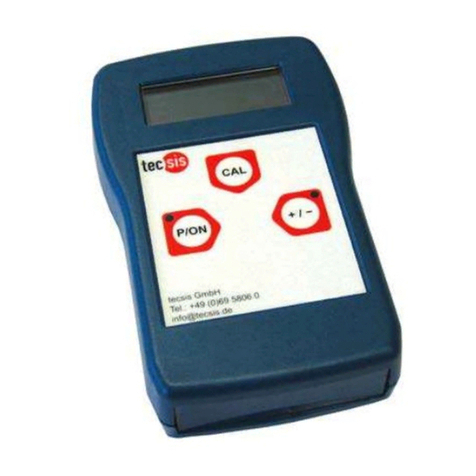
Tecsis
Tecsis E3906 User manual
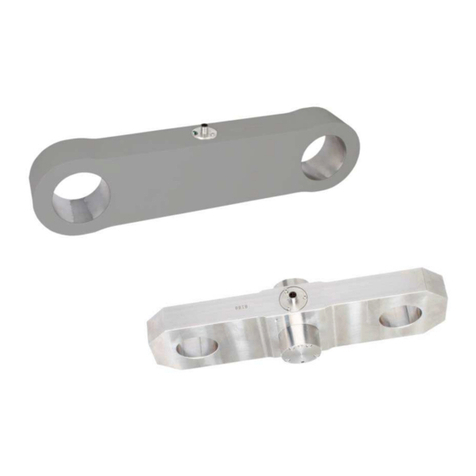
Tecsis
Tecsis F7301 User manual
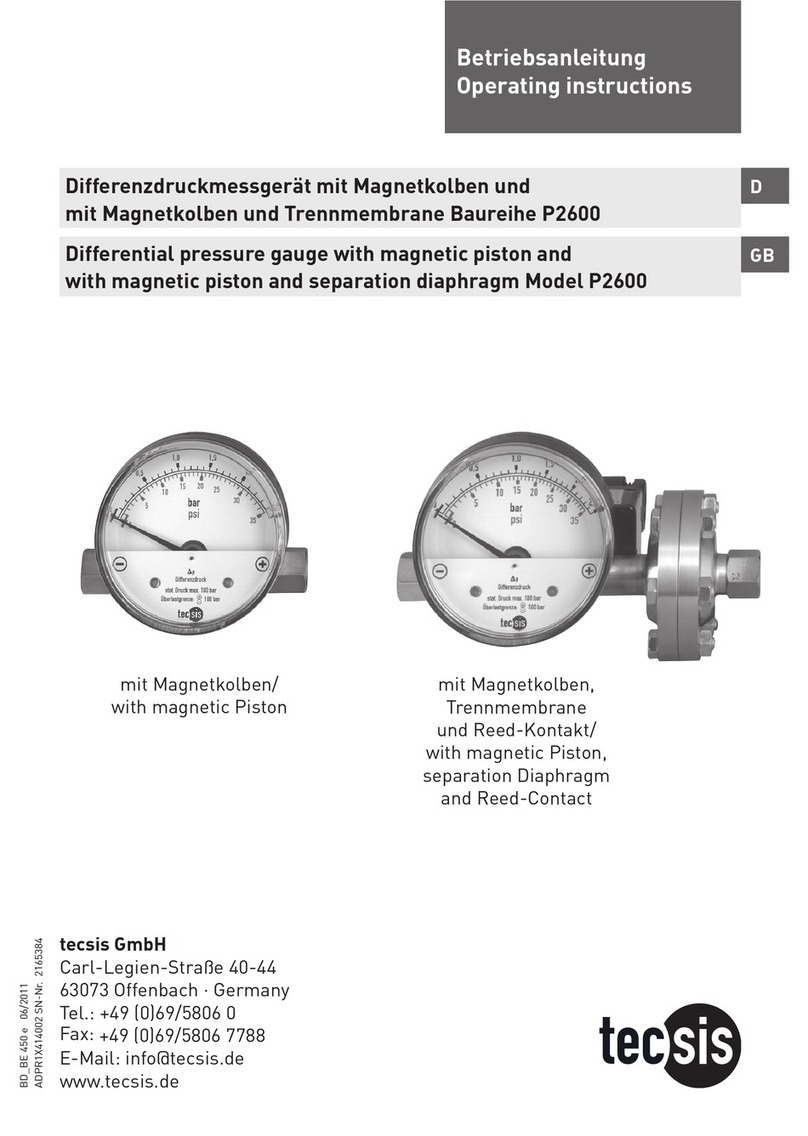
Tecsis
Tecsis P2600 User manual

Tecsis
Tecsis P2590 User manual
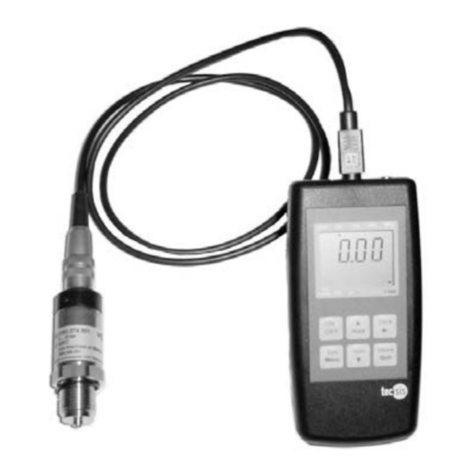
Tecsis
Tecsis Manoport E3905 User manual

Tecsis
Tecsis E1999X500 User manual
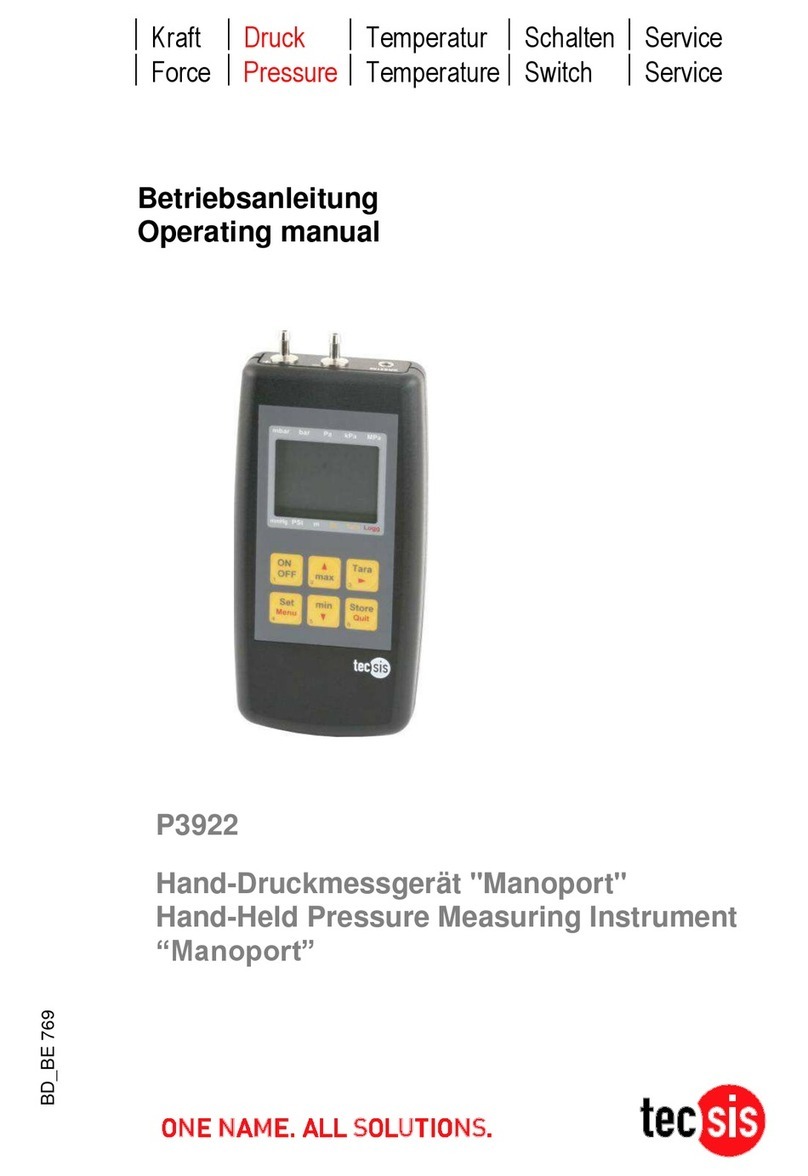
Tecsis
Tecsis P3922 User manual
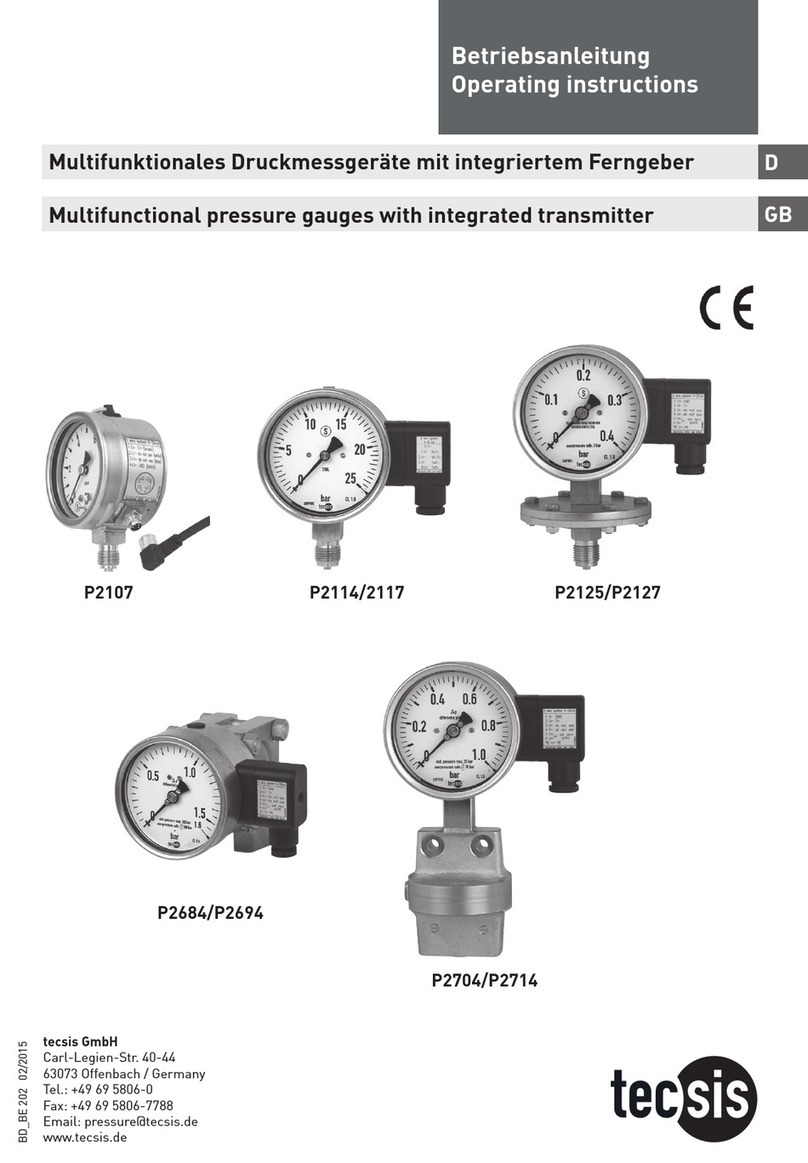
Tecsis
Tecsis P2107 User manual
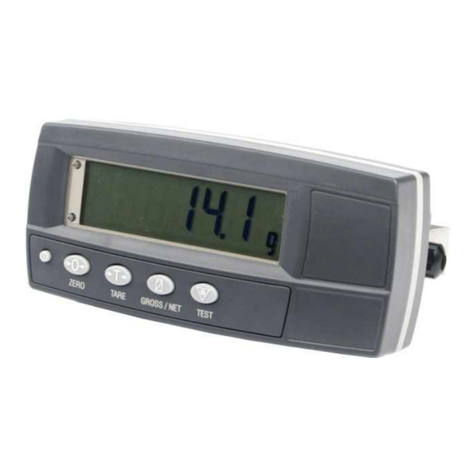
Tecsis
Tecsis E1932 User manual
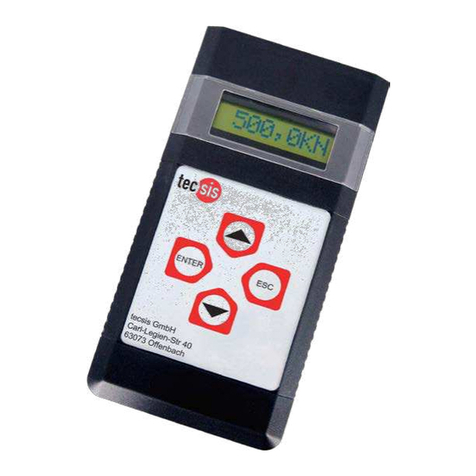
Tecsis
Tecsis E3907 User manual
